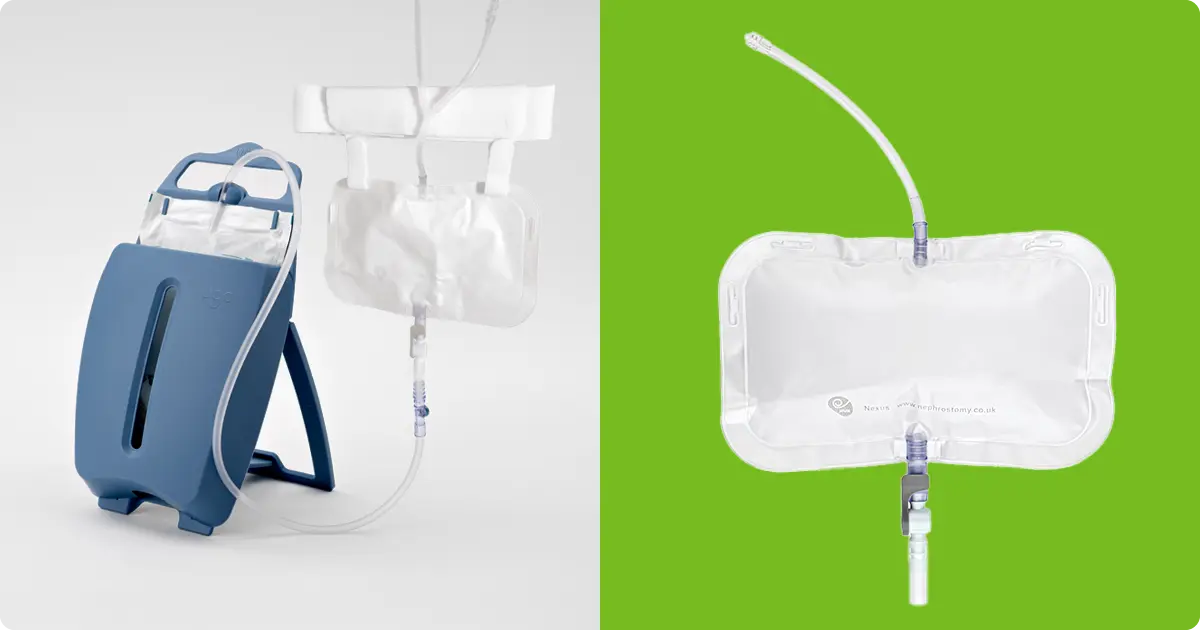What is a nephrostomy?
A nephrostomy is a thin plastic tube that allows urine to drain from your kidney. It is inserted through the skin on your back into your kidney. In some cases, you might have two tubes, one into each kidney.
A nephrostomy procedure is usually done when something is blocking your normal flow of urine from your kidney to your bladder. Once inserted, your nephrostomy will drain urine straight from your kidneys into a collection bag that is either strapped to your waist or leg.
A nephrostomy can help your kidneys to function properly, clear any existing infections and protects them from any further damage. Most of the urine will leave your body via your urostomy tube(s) but you might still pass a little bit the normal way.
The procedure is a great option to reduce any strain on the kidneys without having to have surgery. This gives your healthcare professional time to figure out how to treat the blockage in your ureters. Once the blockage is removed and you can pass urine normally again, your nephrostomy tubes can be removed, and your urinary tract will work as normal again.

What can lead to a nephrostomy?
As we already know, a nephrostomy is usually performed when one or both of your ureters are blocked. Sometimes, it is not clear what the cause of the blockage is, but some of the most common causes are kidney stones, a severe kidney infection, injury, trauma, or cancer. Nephrostomies are also common if you’re in your 3rd trimester of pregnancy, the baby can press against your urinary system blocking the ureters. Once the baby is born, the nephrostomy is no longer needed and will be removed.
What are the potential risks of a nephrostomy?
Although a nephrostomy is generally considered a safe procedure, complications are possible. The most common risk is, that you develop an infection. So, if you experience any of the following symptoms after your nephrostomy procedure, please do get in touch with your nurse or doctor.
Most common side-effects after a nephrostomy:
- Pink or red urine, this should settle within 48 hours. Inform your Healthcare Professional if it doesn’t.
- Swelling, redness, or tenderness where the tube was placed
- Leaking of urine
Although very rare, other possible complications include:
- Bleeding (Some minor bleeding is normal within the first 48 hours after your procedure)
- A dislodged nephrostomy tube
There is also a chance for your nephrostomy tubes to become blocked. If any of the following occur, contact your Healthcare Professional:
- You are unable to flush your tubing
- Poor or no urine drainage for over 2 hours
- Leaking of urine from the dressing or the tube
- Your nephrostomy tube falls out
What happens before a nephrostomy procedure?
Before your nephrostomy procedure your healthcare professional will talk you through everything and you will have the chance to ask any questions you might have.
Before you have a nephrostomy tube inserted you will have a routine blood test just to make sure that everything is normal. It is important that you tell your doctor about any medications or supplements that you’re currently taking. There are some medicines, like blood thinners, that you might have to stop taking prior to your procedure but your doctor will instruct you when to stop taking them. Do not stop taking any tablets without consulting with a nurse or doctor first.
Your doctor might also tell you when you can eat and drink before the procedure. Make sure to tell your doctor about any allergies, especially if you’ve previously had a bad reaction to an intravenous contrast medium. This is the special dye that is used for kidney X-rays and CT scanning.
If you develop any symptoms of an infection shortly before your procedure – like fever or night sweats – let your nurse or doctor know about it. It might not be safe for you to have your nephrostomy done with an infection.
You should also tell your healthcare professional if you have any of the following:
- An artificial heart valve
- A heart stent
- A pacemaker or defibrillator
- An artificial joint or blood vessel graft
- A neurosurgical shunt
- Any implanted foreign body
- If you’ve ever had a MRSA infection
What happens during a nephrostomy procedure?
The whole procedure will normally take less than an hour to complete and will be carried out by a specialist radiologist at a hospital. You will first change into a hospital gown. You will then get an x-ray so that the radiologist can find where the best place on your back is to insert the tube, you will then be given local anaesthetic to help relieve any pain where the tube is inserted.
What happens after a nephrostomy procedure?
Even though you won’t be put under general anaesthetic you will likely be required to remain in bed for a few hours after the procedure. Shortly after your procedure it is normal to experience a little pain. This usually only lasts for a short period of time, however, and can easily be managed with over-the-counter pain relief such as paracetamol. You might also experience some bruising and your urine can be a little blood stained. These problems usually all clear up within the first 1 to 2 days. Please make sure to mention it to your nurse or doctor if this isn’t the case.

Will I need someone to be with me after having a nephrostomy procedure?
After your operation you will need someone (friend, relative or care professional) to take you home and be with you for around 24 hours, just to keep an eye on you so that they can report any concerns to your healthcare professional.
When can I go back to work after a nephrostomy procedure?
Your healthcare professional will advise when you can return to work. Normally, unless you have a very physically demanding job, returning to work should not present any problems as long as you have fully recovered from the procedure.
Can I exercise whilst I have a nephrostomy tube inserted?
In short yes, gentle exercise such as a short walk is fine. But more strenuous exercise such as running should be avoided as it may cause you pain. You should also avoid swimming or submerging your catheter in the water before taking advice from your healthcare professional.
Can I have sex whilst I have a nephrostomy tube inserted?
Nephrostomy tubes can often leave you feeling anxious or embarrassed when it comes to being intimate. But you should know that there are no restrictions on intimacy and sexual intercourse once you have recovered from your surgery. If you are worried about your tubes becoming dislodged make sure they are secured with a catheter fixation device like a silicone adhesive strip.
You can find catheter fixation devices on the Vyne Shop here
You can find nephrostomy fixation and drainage bags here
References
1. https://www.uhsussex.nhs.uk/resources/nephrostomy-tube/

